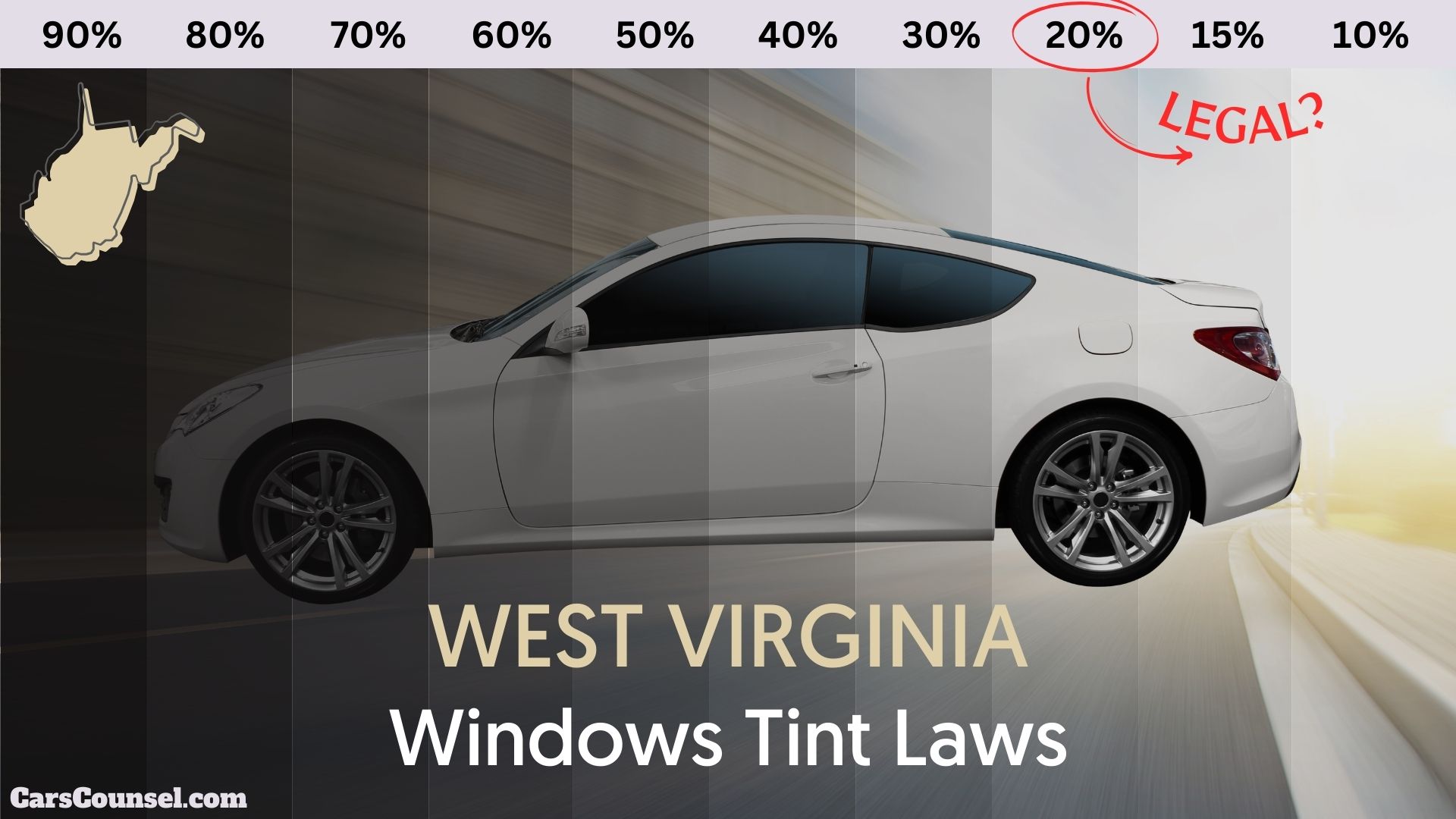As you navigate the Mountain State’s winding roads, a veil of darkness may be tempting, but beware: West Virginia’s window tinting laws are watching, like a hawk perched on a roadside billboard. You’re probably wondering what’s allowed and what’s not.
The truth is, the rules can be as murky as a foggy morning on the Kanawha River. But don’t get caught in a haze of confusion – understanding the laws can save you from a costly ticket. So, what’s the deal with West Virginia’s window tinting laws, and how can you avoid getting pulled over?

Quick Navigation
Window Tint Laws Overview
With window tint laws dating back to 1991, West Virginia has a long history of regulating the level of tint permitted on vehicle windows.
As a driver in West Virginia, it’s essential to understand the window tinting laws to avoid fines of up to $200 per infraction.
The law requires a minimum of 35% light transmission through the front windows, measured by Visible Light Transmission (VLT) percentage. This means that at least 35% of visible light must be allowed to pass through your front windows.
Understanding West Virginia Window Tint Laws is vital to guarantee adherence and avoid repeated citations. By following these window tinting rules, you can protect your vehicle’s interior from UV damage while staying within the bounds of the law.
[adinserter block=”17″]
Windshield and Window Tint Rules
In West Virginia, understanding the specific rules governing windshield and window tint is essential to avoiding fines and ensuring your vehicle meets the state’s regulations. You need to know that non-reflective window tint is allowed on the top 5 inches of the windshield, marked by the AS-1 line, and cannot be yellow, amber, or red in color.
| Window Type | Visible Light Transmission (VLT) Requirement |
|---|---|
| Windshield | Top 5 inches: non-reflective, no yellow/amber/red tint |
| Side Windows | At least 35% VLT |
| Rear Window | At least 35% VLT |
| Multi-Purpose Vehicles (MPVs) | No VLT restriction, up to 20% reflective window film |
Vehicle Type-Specific Regulations
Typically, the type of vehicle you own determines the window tinting regulations you need to follow in West Virginia.
As a passenger vehicle owner, you’ll need to certify your side windows and rear window allow at least 35% of visible light to pass through.
However, if you own a multi-purpose vehicle (MPV) like an SUV or van, the rules are different.
You can apply window film with any darkness level to your rear side windows and rear windshield. Still, your front side windows must guarantee at least 35% of visible light to pass through.
Additionally, MPV window film can be up to 20% reflective, but yellow, amber, and red window tint colors are prohibited.
Metallic tint colors are permitted on both passenger vehicles and MPVs.
Medical Exemptions and Exceptions
Certain medical conditions can exempt you from West Virginia‘s window tinting laws.
If you have a medical condition that requires you to limit your exposure to sunlight, you may be eligible for a medical exemption. This exemption allows you to have a darker tint on your windows, specifically on the top 5 inches of the windshield and on your side windows.
Must allow at least 35% of light to pass through, and you must certify the film you use meets West Virginia Window Tint Laws.
The state allows medical exemptions for certain conditions, such as melanoma, porphyria, and photosensitivity.
If you think you qualify, consult with a medical professional and submit the required documentation to obtain an exemption.
Penalties and Enforcement Details
Compliance with West Virginia’s window tinting laws is crucial, as noncompliance can result in penalties.
If you’re caught with illegal window tint, you’ll face fines and penalties. Law enforcement officers are trained to identify legal tinting and can easily spot non-compliant vehicles.
They’ll look for the certified sticker on your windshield, which reflects your adherence with West Virginia Window Tint rules and regulations. If you’re exempt due to medical conditions, you’ll need to carry proof of your medical exemptions.
Don’t risk the penalties – guarantee you understand the enforcement details and follow the laws. Failure to comply can lead to fines, and in some cases, even vehicle impoundment.
Stay informed to avoid these consequences and enjoy safe, legal driving in West Virginia.
Tint Law References
West Virginia Code, Article 17C, Chapter 15, Section 17C-15-36a: Sun-screening devices; penalty
Car Window Tinting Laws By State
Click on the state you’re interested in for a complete guide to its tint laws and regulations. If you spot any errors, let us know through our contact page.
| State | Front Side Windows | Back Side Windows | Rear Windows | Windshield |
|---|---|---|---|---|
| Alabama | 32% | 32% | 32% | 6 inches |
| Alaska | 70% | 40% | 30% | 5 inches |
| Arizona | 33% | ANY | ANY | tinting allowed to the top of the manufacturer’s as-1 line |
| Arkansas | 25% | 25% | 10% | 5 inches |
| California | 70% | ANY | ANY | 4 inches |
| Colorado | 27% | 27% | 27% | 4 inches |
| Connecticut | 35% | 35% | ANY | non-reflective tint above the as-1 line top 6 inches |
| Delaware | 70% | ANY | ANY | non-reflective tint above the as-1 line top 6 inches |
| Florida | 28% | 15% | 15% | non-reflective tint above the as-1 line |
| Georgia | 32% | 32% | 32% | 6 inches |
| Hawaii | 35% | 35% | 35% | Non-reflective tint is allowed on the top 4 inches of the windshield |
| Idaho | 35% | 20% | 20% | non-reflective tint above the as-1 line |
| Illinois | 35% | 35% | 35% | 6 inches |
| Indiana | 30% | 30% | 30% | non-reflective tint above the as-1 line |
| Iowa | 70% | ANY | ANY | non-reflective tint above the as-1 line |
| Kansas | 35% | 35% | 35% | non-reflective tint above the as-1 line |
| Kentucky | 35% | 18% | 18% | non-reflective tint above the as-1 line |
| Louisiana | 40% | 25% | 12% | non-reflective tint above the as-1 line top 6 inches |
| Maine | 35% | 35% | 35% | top 4 inches |
| Maryland | 35% | 35% | 35% | top 5 inches |
| Massachusetts | 35% | 35% | 35% | top 6 inches |
| Michigan | 35% | ANY | ANY | top4 inches |
| Minnesota | 50% | 50% | 50% | Top 6 inches |
| Mississippi | 28% | 28% | 28% | non-reflective tint above the as-1 line top 5 inches |
| Missouri | 35% | ANY | ANY | non-reflective tint above the as-1 line top 6 inches |
| Montana | 24% | 14% | 14% | non-reflective tint above the as-1 line top 6 inches |
| Nebraska | 24% | 20% | 20% | top 6 inches or as-1 line, whichever comes first |
| Nevada | 35% | ANY | ANY | non-reflective tint above the as-1 line top 6 inches |
| New Hampshire | 35% | 35% | 35% | Allowed for the manufacturer’s AS-1 line |
| New Jersey | Illegal | ANY | ANY | Top 6 inches |
| New Mexico | 20% | 20% | 20% | 5 inches or as-1 line, whichever comes first |
| New York | 70% | 70% | 70% | top 6 inches |
| North Carolina | 35% | 35% | 35% | non-reflective tint above the as-1 line top 6 inches |
| North Dakota | 50% | ANY | ANY | Top 6 inches |
| Ohio | 50% | ANY | ANY | Top 5 inches |
| Oklahoma | 25% | ANY | ANY | 5 inches or as-1 line, whichever comes first |
| Oregon | 35% | 35% | 35% | Top 6 inches |
| Pennsylvania | 70% | 70% | 70% | Top 3 inches |
| Rhode Island | 70% | 35% | 35% | non-reflective tint above the as-1 line top 6 inches |
| South Carolina | 27% | 27% | 27% | non-reflective tint above the as-1 line top 6 inches |
| South Dakota | 35% | 20% | 20% | non-reflective tint above the as-1 line top 6 inches |
| Tennessee | 35% | 35% | 35% | non-reflective tint above the as-1 line top 6 inches |
| Texas | 25% | 25% | 25% | 5 inches or as-1 line, whichever comes first |
| Utah | 43% | ANY | ANY | non-reflective tint above the as-1 line top 4 inches |
| Vermont | 70% | ANY | ANY | ILLEGAL |
| Virginia | 50% | 35% | 35% | non-reflective tint above the as-1 line top 6 inches |
| Washington | 24% | 24% | 24% | Top 6 inches |
| West Virginia | 35% | 35% | 35% | Top 5 inches |
| Wisconsin | 50% | 35% | 35% | non-reflective tint above the as-1 line top 6 inches |
| Wyoming | 28% | 28% | 28% | Top 5 inches or as-1 line, whichever comes first |

